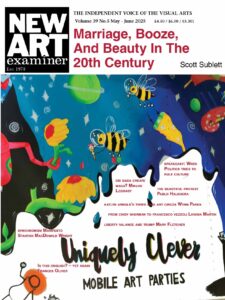
Computer Bank
Catheryne Kelly
Last issue saw Al Jirikowic equate the NFT to ‘mental dust’, and as this phenomenon continues it’s high time to lift it’s veil of total intangibility with a brief glance towards Conceptualism.
“[P]rofound changes are impending in the ancient craft of the Beautiful” said Paul Valéry, and if I were as gifted a wordsmith, I would have uttered the same upon furiously clicking through my first block-chain-based virtual exhibition. Hosted by Francisco Carolinum, Austria, it was all very Minecraft-esque. After ‘spawning’ as an invisible avatar you’re free to teleport across a vast, multi-story digital gallery space to survey all the oddities that this metaverse has to offer; tanks, aliens, zombie Furbies, Nyan Cats and glitchy cartoon nudes. Not for long though, while it’s already headache-inducing for me, the psychedelia of it all seems all too much for my elderly laptop, the ‘gallery’s’ ambient background music stutters, some internal fan begins to whir, and the web page crashes.

Many of us expected the hype around NFTs to falter in a similar fashion – to have internally combusted under the sheer absurdity of their premise – but whether we like it or not, it looks like they’re here to stay. Now a crypto artist boasts of being among the top three most valuable living artists of all time, raking in over $69 million for a work that makes motifs of beheaded Buzz Lightyear and naked Donald Trump. But how on earth did we get here? Of course, we could plumb the depths of digital art history to fish out direct ancestors of the NFT and find Andy Warhol to be the patriarch, making scrappy sketches of his usual insignia – soup can, banana, flower et al – on his Commodore Amiga 1000 in the 1980s. Yet much of the theory behind the form, and certainly much of what is tantalizingly frustrating about it, isn’t new and is, rather, in complex dialogue with the Conceptualist movement.
Any cynic worth their salt knows that NFTs are, first and foremost, hampered by their claim of immateriality, so custodians attempt to refute this by referring to the NFT as a modern continuation of Conceptualism. The argument goes that Conceptualism’s focal shift away from the materialism of the art object and towards the idea embedded in it, as represented by instructional documentation, legitimizes the NFT as an intangible form almost by default. After all, when an NFT is purchased, what is really bought is documentation on the blockchain denoting the transaction because ownership of the ‘art’ itself is a slippery concept when everyone else on the internet can access your content for free. And thus, a market is made for virtual bragging rights.
While we’ll see that the course of this comparison does not run smooth, there’s nevertheless a lot to be said here about this merging of artwork and paperwork, and we’ve got Marcel Duchamp to thank for much of it. Although his Monte Carlo Bonds (1924) slightly predate the movement he spearheaded, crypto artists such as Rhea Myers have picked up and ran with the questions they raise, after proving central to the NFT experience. Behind the Bonds is the idea of purchasing an artist’s ‘receipt’; you fund their craft (or their gambling, in Duchamp’s case) and, with any luck, get a share of an appreciating asset in return. While Duchamp is referenced across the body of Myers’ work, this idea in particular is brought into the 21st century in her project “Is Art”. Here she attempts to transcend materiality by using the NFT as a medium in itself. It is no longer merely a blockchain registry tool. Much like the Bonds, the art here is a document and the document, in turn, ‘is’ the art. And with that, the Duchampian ‘ready-made’ has made its comeback.
Yet, much like Fountain (which has, coincidently or no, become a popular symbol of NFT art) all rests on the act of nomination. For her work, Myers set up an Ethereum smart contract that contains the assertion that it either “is” or “is not” art and any investor who has access to the contract can elect its status – a status that is legitimized by its place on the blockchain. The entire endeavour, however novel, seeks to rekindle Conceptual debates aired nearly a century ago. We’re still left asking if a document can ever actually ‘be’ art. If so, where do we draw the line? And, just as importantly, who gets to draw it? Can this be a collective endeavour? However ironically, Myers is drawing upon the democratic veneer of crypto markets, which self-present as a decentralized system that big players can’t monopolize. Cheery thought that, but after the apotheosis of the likes of Beeple, it’s not the practical reality.
There’s another catch though, if we were to accept wholeheartedly that a document can be art we’d also have to accept, in turn, the concept that art can be no more than an idea. Now we’re in hot water, and this is where NFTs take a break from their Conceptual connection. While the movement attempts to de-commodify the material artefact by reducing it to a linguistic level, NFTs actually confront us with the inverse. We’re now being faced with a system that monetises freely available content and does so on a blockchain that is powered by very real infrastructure that produces very real environmental implications. To legitimise the status of “Is Art” on the blockchain, for instance, it takes “the strength of millions of dollars of computing power a day.” So, while on the surface it may not seem as such, nothing in this game is inconsequential. Ultimately, NFTs can never evade the material.
Needs must, and when faced with this fad that’s gone too far it’s comforting to grasp onto any ties that may embed it in an organised past, a past, we’ve seen now, to be less dormant than it once was. But art imitates life and NFTs parachute us into unprecedented territory, and while too neat a fit into art history risks subscription to the NFT’s guise of immaterialism, debates provoked by Conceptualism are certainly useful in navigating this uncertain terrain.
Volume 36 no 1 September / October 2021

